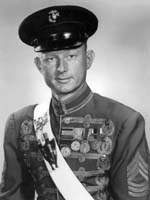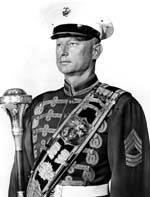

Edmond DeMar
Drum Major, 1949-1958
Drum Major Edmond DeMar enlisted in the U.S. Marine Corps in 1935 and was sent to Marine Barracks Washington to perform trumpet and cornet with the United States Drum and Bugle Corps in 1936. He provided the following account of being selected for drum major training:
“On Friday afternoons we younger men were assigned to [clean] the barracks and offices in preparation for inspection. On one of these details I found myself assigned to clean the colonel’s office. In the process of dusting over the door, the colonel came in and remarked that I was tall enough to clean over the high doorway without using a stepladder. Small wonder, for although I was only 18 years old, I was 6’4” tall. Shortly thereafter, at the colonel’s request, I was taught to be a drum major and this was to become my specialty.”
DeMar left Marine Barracks Washington to join the combat forces in the South Pacific during World War II. In 1949 he was selected to become the Marine Band’s 28th Drum Major and in 1953 he was sent to England to study the Royal Marine Band and Drum and Bugle Corps. As a result, he redesigned the Drum Major’s baldric, which was described in a press release at the time:
“A baldric, of teutonic origin, was known originally as a baldrei and was used to carry a bugle or sword. Drum majors of British and other foreign musical organizations use this baldric extensively. The Marine Band baldric is patterned after and is similar to the British baldrics in principle. The Marine Band baldric was made by the Marine Corps Depot of Supplies in Philadelphia. The silver work was done by Henry Potter and Company of London, England. The baldric itself consists of a sash of black felt edged with gold braid striped in red. Several plates of silver are attached to this sash. First, a plate of silver with the ‘United States Marine Corps’ inscribed at the top. Below this is a large silver shield with the Marine Emblem embossed. Then there are four pieces of silver plate with the major campaigns of the Marine Corps … In addition, the personal decorations (medals) of the wearer, in miniature, are attached at the top. The Drum Major’s insignia is symbolized by two drum sticks with brass heads flanking the campaign plates on each side of the sash.”